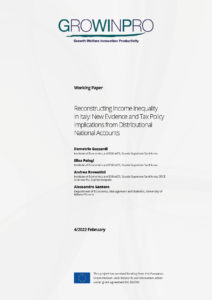This work reconstructs novel series on income distribution in Italy combining survey data, tax data and National Accounts both at the national and regional levels, and it analyzes the overall progressivity of the tax system. Our new Distributional National Accounts allow to correct for remarkable misreporting of capital income in surveys, to provide more accurate estimates of consumption, and to better account for the role of informal economy. Our fresh estimates show higher income concentration at the top 10%, 1% and 0.1% with respect to previous studies in order of 2 to 3 percentage points. Moreover, the share of national income of the richest top 10%, top 1% and top 0.1% has been steadily increasing after the 2008 crisis. Our results shed further light on the multifaceted nature of inequality in Italy: youngest individuals, women and inhabitants of Southern regions have been increasingly exposed to growing levels of inequality. Finally, the Italian tax system is only slightly progressive up to the 95th percentile of the income distribution, and regressive for the top 5%. Moreover, it is regressive throughout the whole distribution when individuals are ranked with respect to their net wealth. Simulation exercises show that radical measures, such as a wealth tax, are needed to eradicate the regressivity of the Italian tax system.
 Reconstructing Income Inequality in Italy: New Evidence and Tax Policy Implications from Distributional National Accounts
Reconstructing Income Inequality in Italy: New Evidence and Tax Policy Implications from Distributional National Accounts
Demetrio Guzzardi
Elisa Palagi
Andrea Roventini
Alessandro Santoro
working paper 4/2022
